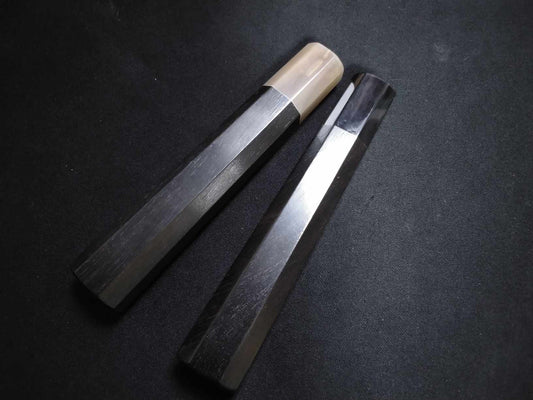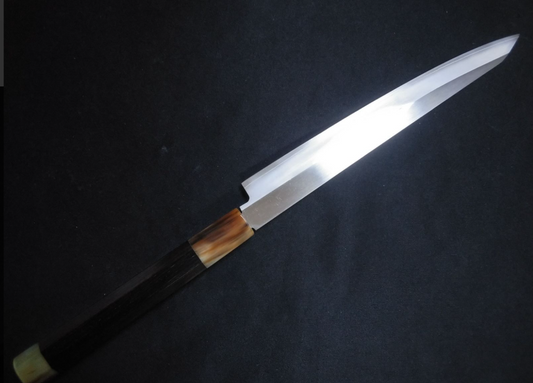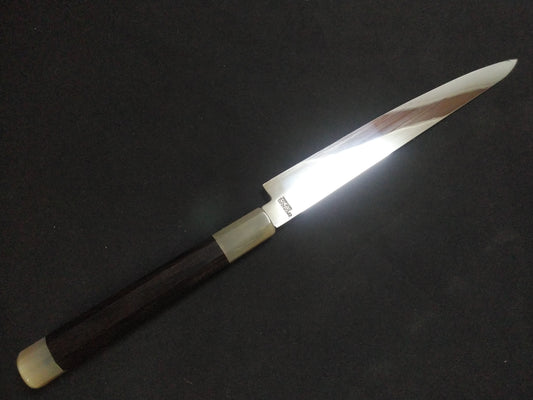
Petty Knife: The Small Blade That Does It All
-
From fruit to fine garnishes, the petty knife brings precision and style to every cut. Discover why this compact blade is a must-have.
-
Petty Knife Collection
-
Super Steel (Honyaki) Petty 180mm
Regular price $350.00 CADRegular priceUnit price / per$0.00 CADSale price $350.00 CAD -
ZDP189 Petty 210mm-Kido Finishing
Regular price $420.00 CADRegular priceUnit price / per$0.00 CADSale price $420.00 CAD -
ZDP189 Petty 210mm-Polished(both sides)
Regular price $527.00 CADRegular priceUnit price / per$0.00 CADSale price $527.00 CAD -
Super Steel (Honyaki) Petty 210mm -Mirror Polished(both sides)
Regular price $603.00 CADRegular priceUnit price / per$603.00 CADSale price $603.00 CADSold out
KIREAJI's Three Promises to You
-

1. Exceptional Japanese Knives
Our knives, crafted by Sakai City's master artisans, combine traditional techniques with carefully selected materials, delivering unrivaled sharpness and durability.
-

2. For a Lifetime of Use
At KIREAJI, we see knives as lifelong companions. Each knife comes with a free saya, and we offer Honbazuke hand-sharpening by Shiroyama Knife Workshop in Sakai City.
-

3. Supporting the Joy of Continued Use
KIREAJI knives are made to grow with you. That’s why we provide trusted after-sales care (fee-based) .
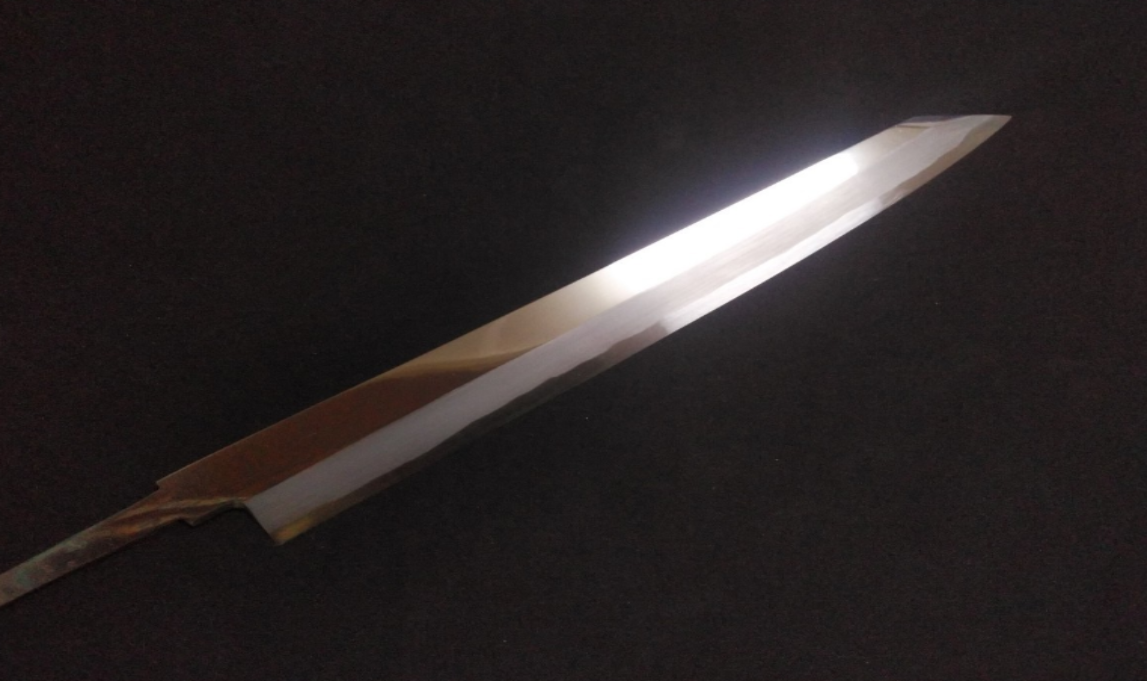
Why Many Product Photos Show Only the Blade
At KIREAJI, every knife is Made to Order.
That means your knife is completed — handle attached and final adjustments made — only after you place your order, by skilled artisans in Sakai, Japan.

Global Delivery from Sakai
Across the world, discerning customers seekgenuine Japanese knives crafted in Sakai.
At KIREAJI, we work alongside the master artisans of Sakai to fulfill that desire — shipping authentic Japanese knives straight from Sakai to kitchens around the globe.
Petty
-
What Is a Petty?
A Petty is a small, versatile kitchen knife that’s perfect for handling everyday tasks like peeling fruits, slicing a few vegetables, or trimming meat and fish. With a typical blade length of 120mm to 210mm, it’s compact, easy to handle, and ideal for cooks who want a go-to knife for quick, precise work.
By the way, did you know that a Petty is essentially the same as a paring knife?
“Paring knife” is the term commonly used in English-speaking countries, named after the peeling (paring) motion it’s designed for. In Japan, however, the French word petit (meaning “small”) gave rise to the name Petty, which has become the standard term here. So, even though the names differ, they refer to the same type of knife. -

For When You Just Need to Cut “a Little”
We’ve all been there — you only need to cut a couple of cherry tomatoes or slice a lemon wedge. Pulling out a full-sized chef’s knife can feel like overkill.
That’s where the Petty truly shines. It’s nimble, easy to clean, and light — a perfect sidekick to your main knife, always ready when you just need to do a little prep. -
Japanese Craftsmanship in a Small Blade
You might think, “It’s just a small knife — how different can it be?” But in Japan, even the smallest blades are crafted with the same attention to detail as a full-sized Gyuto. From heat treatment to sharpening and handle design, skilled artisans pour their expertise into every step.
Traditional Japanese handles — often octagonal or round — are shaped to fit comfortably in the hand, offering a grip that feels both natural and precise. A Petty may be small, but it carries the full weight of Japanese craftsmanship.
-

Why Chefs Around the World Love It
Japanese Petty knives from brands like KIREAJI have gained international recognition among professional chefs and home cooks alike.
Why? Because they offer incredible sharpness and versatility — far beyond just peeling fruit. Whether it’s shaping vegetables, trimming meat, or delicately cleaning small fish, a quality Petty handles it all with ease.Most Petty knives are also double-edged, making them easy to use for both right-handed and left-handed users. In professional kitchens where speed and precision matter, a well-balanced small knife is often just as important as a large one.
-
In Conclusion: Great Knives Come in Small Sizes
Whether you call it a petty knife or a paring knife, the essence remains the same — a compact tool packed with precision and tradition.
Adding just one to your kitchen can expand your cooking options and improve your workflow. That’s the beauty of the petty knife: it makes everyday cooking more enjoyable, more efficient, and more inspired.So why not add a “small but mighty” companion to your kitchen? You’ll be surprised how often you reach for it.
Why Petty, Not Gyuto? — The Precision Only a Small Knife Can Offer
-
When you first get serious about knives, chances are your go-to blade is the Gyuto.
It’s the workhorse of the kitchen — a well-balanced, all-purpose knife that can handle vegetables, meat, and fish with ease.But as your knife skills evolve, there comes a moment when you start to feel:
“I need something that moves with a little more freedom.”That “something more” is the Petty.
The Petty knife, widely loved by both professionals and home cooks in Japan, is a small utility knife ideal for detailed tasks.
In English, it’s often called a “paring knife,” but in Japan, the French-derived term “Petty” (from petit, meaning “small”) is firmly established.But make no mistake — being small isn’t a compromise. It’s a deliberate strength.
-

What Petty Can Do That Gyuto Can’t
Gyuto knives generally start at 210mm. Their size requires broad motions and space.
The Petty, on the other hand, is typically around 120–150mm — almost an extension of your hand. That gives it a tremendous advantage in precision work:- Peeling fruit and cutting along delicate fibers
- Picking parsley leaves one by one
- Trimming thin membranes from cured meats
- Final touch-ups in plating and presentation
These are tasks where a Gyuto isn't impossible — just impractical.
And in the real world, it’s that fine control that sets great cookin
-
For Professionals and Home Cooks Alike
In many kitchens across France and Scandinavia, chefs carry both a Gyuto and a Petty as their essential pair.
The Gyuto is for "cutting." The Petty is for "touching."Once you use a Petty, you'll immediately notice the superior control, agility, and comfort it offers for delicate work.
Even at home, a large knife can feel awkward when peeling apples or coring tomatoes.
The Petty simply removes those little moments of discomfort. -
More Than Efficiency — It's About Intention
Sure, efficiency matters. But the Petty isn’t just about working faster —
it’s about working beautifully.With minimal effort and zero strain, you shape ingredients gracefully.
When your fingertips and blade tip move in harmony, your technique sharpens.
Petty represents that shift in mindset — from “how fast” to “how well.”In a world where food is shifting from quantity to quality,
the Petty is the perfect tool for this new era of cooking. -

The Petty: Not a Backup — A Quiet Ace
The Petty may look like a secondary tool beside the mighty Gyuto.
But in small spaces, for precise cuts, in final finishing touches —
it quietly becomes your most trusted blade.It’s not just a “nice-to-have.”
It’s the second knife every cook needs — because it opens up a world the first knife never could.
FAQ About Petty
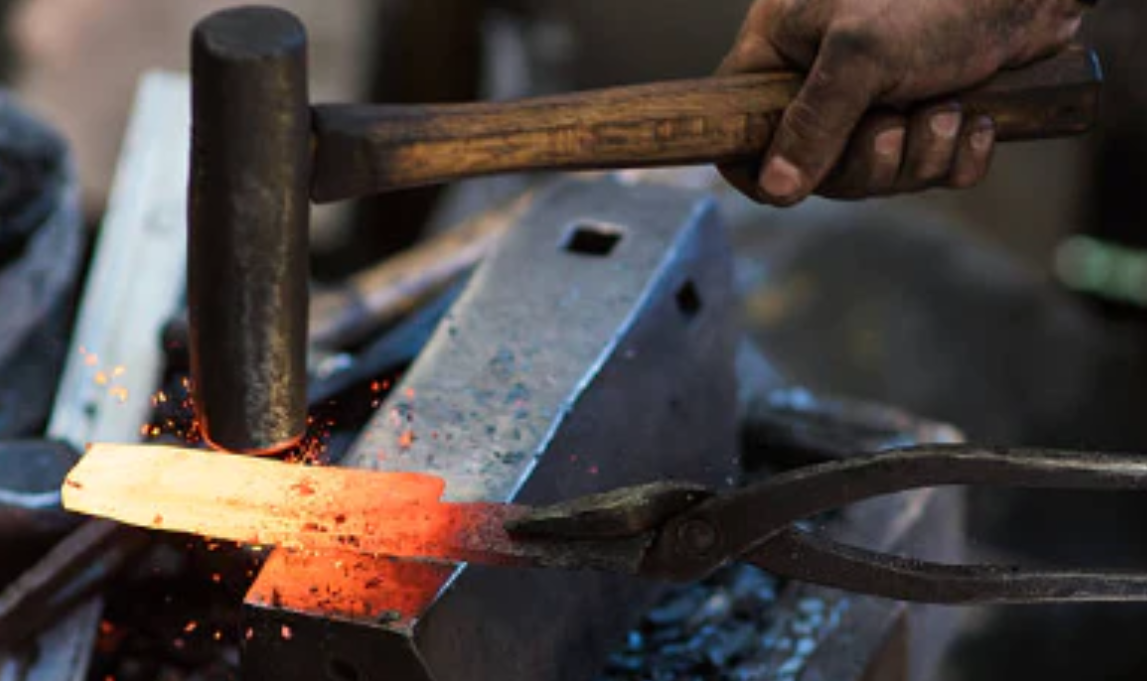
01. What is a Petty knife?
The Petty knife is a small, lightweight utility knife used for fine and detailed tasks in the kitchen. It’s considered the Japanese equivalent of a Western paring knife, but with a longer and more versatile blade.
02. What are the strengths and weaknesses of a Petty knife?
Strengths:
ー Ideal for peeling, trimming, and dicing small ingredients
ー Great for segmenting fruits and making decorative cuts
ー Suitable for detailed tasks such as deveining shrimp or trimming fat
ー Excellent control due to its compact size
Weaknesses:
ー Not suitable for cutting large ingredients or dense items
ー Unsuitable for cutting through bones or frozen foods
ー Limited power and leverage compared to larger knives like Gyuto or Deba
In short, the Petty knife excels at delicate, precision-based tasks but should be paired with larger knives for heavy-duty work.
03. What types of tasks is a Petty knife best suited for?
The Petty knife is best for:
ー Peeling vegetables and fruits
ー Trimming herbs, meat, or fish
ー Creating decorative garnishes
ー Making small, precise cuts on or off the cutting board
Its slim profile and light weight make it perfect for in-hand work or for chefs with smaller working spaces.
04. Who is a Petty knife recommended for?
The Petty knife is ideal for:
ー Home cooks looking for a versatile small knife
ー Beginners who want better control than with larger knives
ー Professional chefs who require precision in trimming or plating tasks
The more you use it, the more you'll appreciate its speed, control, and convenience in everyday cooking.

The Origin of Craftsmanship
-
The Charm of the Petty Knife—Experience the Craftsmanship in Everyday Use
The petty knife is not just a small knife. This tool, perfect for everyday tasks, embodies the craftsmanship of the maker. When it comes to detailed work, its sharpness and compact size are nothing short of perfect. Whether cutting fruit or handling small quantities of ingredients, the petty knife shines in its role.
-
Each petty knife we use carries the sharpness and usability that craftsmen meticulously shape. The technique embedded in the small blade brings color to everyday cooking, and every time you hold it, you can feel the precision and care in the work.
-
Where larger knives may not reach, the petty knife works like an extension of your hand, making fine tasks effortless. This convenience, along with its beautiful form, makes it a tool you grow fond of with each use.



